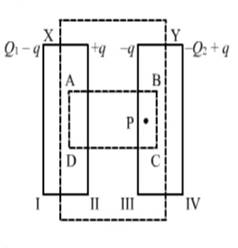Suppose a charge + Q1 is given to the positive plate and a charge –Q2 to the negative plate of a capacitor. What is the “charge on the capacitor”?
Given:
Charge on positive plate=Q1
Charge on negative plate=Q2

Assume a rectangular gaussian surface ABCD as shown in fig.
Let the charge on the capacitor plates be “q” and the area of plates be A. Then,
Charge appearing on face 1=Q1-q.
Charge appearing on face 2=q.
Similarly,
Charge appearing on face 3= -q.
Since, the total charge enclosed by a closed surface =0)
Charge appearing on face 4=Q2 +q.
Formula used:
We know that,
I) Electric field inside any conductor=0.
∴ Electric field at point Pinside plate)=0.
E1+E2+E3+E4=0 …i)
This Electric field is the net effect of fields at point P due to faces I, II, III and IV.
II) Electric field due a thin sheet, E=![]()
Where
E is the electric filed due to thin plate
Q is the total charge enclosed in the gaussian surface
A is the area of the plate
εo is the permittivity of the vacuum
Thus, Electric field at point P due to face I E1=![]()
Electric field at point P due to face II E2=![]()
Electric field at point P due to face III E3=![]()
Electric field at point P due to face IV E4= ![]()
negative sign because electric field due to face IV is in leftwards direction).
Putting the values in equation (i) we get,
![]()
On solving the above equation, we get
Q1-q+q-q-Q2-q=0
Q1-Q2-2q=0
q![]()
Thus, the charge on the capacitor is ![]()